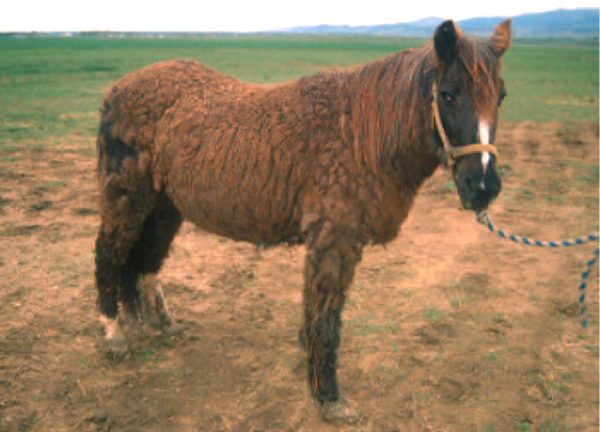
“Cushing’s disease,” or more correctly, pars pituitary intermedia dysfunction (PPID), is a metabolic condition that affects middle-aged and older horses. In PPID, the pituitary gland in the brain produces an excessive amount of the hormone ACTH, which stimulates the production of large amounts of cortisol, the stress hormone. Cortisol has many negative effects in the body, including suppression of the immune system and insulin resistance. There is currently no cure for PPID in horses; instead, it must be managed.
Links in articles are part of an Amazon Affiliate program that provides income to support this brand. Links are chosen by our editors.
Signs of PPID include weight loss, loss of muscle (especially along the topline), a long hair coat that does not shed out in the summer, laminitis, and chronic infections that seem to recur or linger (e.g. hoof abscesses). Generalized obesity is not a typical sign of PPID; however, horses might have fat deposits in certain areas (e.g. over the tail head, neck, and/or shoulder).
In some cases, a veterinarian can diagnose PPID based on the clinical signs alone. In other horses, the combination of clinical signs plus a blood test that measures the ACTH level in the body is needed for diagnosis. A veterinarian might choose to measure insulin and glucose because these markers tend to be elevated in horses with PPID, and some horses can suffer from another condition known as equine metabolic syndrome. In instances where the ACTH test result is inconclusive, or in the early stages of PPID, a veterinarian might need to perform a thyrotropin-releasing hormone stimulation test.
ACTH levels vary throughout the year in all horses, which can complicate the interpretation of blood tests for PPID. Most normal horses show an increase in ACTH in the fall; however, the magnitude of this increase is much higher in horses with PPID compared to normal horses. Therefore, a veterinarian might choose to test for PPID in the fall.
The main treatment for a horse with PPID is daily administration of a medication known as pergolide. In the U.S., there is currently one FDA-approved product (Prascend). When given appropriately, an initial response can be seen in as little as 30 days and long-term improvements will be seen over the period of 1 to 12 months. Your veterinarian will recommend to periodically measure your horse’s ACTH to adjust the horse’s dose as needed.
There are other management considerations for horses with PPID, including dentistry, body condition, body weight, nutrition, and parasite control.
Emily Barrell, DVM, University of Minnesota, authored this article.


